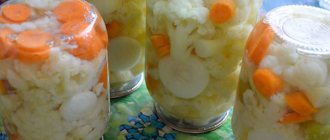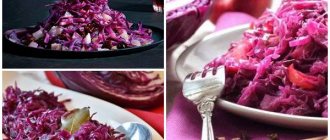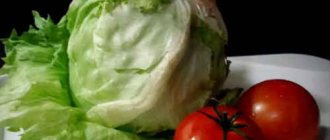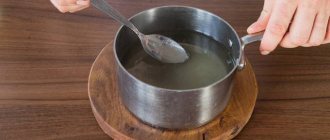Sauerkraut is not only tasty, but also a very valuable product. Nutritionists consider cabbage, after pickling, to be a real storehouse of vitamins. Vitamins support the body's immune system and are involved in many metabolic processes and digestion. Lactic acid bacteria, which are involved in the fermentation process, are useful in the treatment of dysbiosis.
Shredded cabbage is usually fermented.
This recipe is convenient in many ways. The main thing is that the dish does not require additional preparation. Sauerkraut is simply flavored with sunflower oil or added to vinaigrettes, salads, first or second courses. Another factor is that shredded cabbage can be salted with various additives:
- grated carrots;
- raw beets, which will add amazing color to the familiar cabbage;
- spices that improve the usual taste of the vegetable;
- other vegetables for a delicious salad.
And yet, shredded cabbage is convenient to eat. Small slices are ready to eat, and older people also enjoy the healthy pickle with pleasure. But today we’ll talk about an unusual way of fermenting vegetables. This is the pickling of whole heads of cabbage. It sounds unusual, and some have doubts. Will the head of cabbage be able to salt well, will it be crispy and juicy? It turns out that salting cabbage heads is not only simple, but also very convenient. Some housewives cut the head of cabbage into halves or quarters for pickling. These options are also popular.
Which cabbage to choose
It is best to use late varieties of cabbage for preparations. Its heads are denser and juicier, and the leaves are white. The greenish leaves of young cabbage have little sugar, so it turns out less tasty when prepared. You need to choose high-quality vegetables; frozen or rotten heads of cabbage must be mercilessly discarded.
Preparing cabbage is simple; the heads of cabbage will only need to be cleaned of the top leaves, which may be contaminated. Then the cabbage is cut into large pieces, squares or shredded into thin strips, depending on the recipe.
Jars for preparations must be thoroughly washed and, in some cases, sterilized. If canned cabbage is not sealed hermetically, then you need to store it in the refrigerator or in the cellar. If the canned food was sealed with tin lids, then the cabbage can be stored at room temperature.
Interesting facts: sauerkraut is healthier than raw cabbage, as it contains more vitamins. At the same time, the beneficial properties of the product are preserved for more than 10 months.
Terms and features of storage of blanks
Conditions for storing canned early cabbage:
- lack of light;
- temperature 0…+6°С.
If you follow the above standards, you can store such products throughout the year. If you decide to pickle or ferment a variety of early cabbage, then you need to use the appetizer for food within 1 week and store it in the refrigerator.
Early varieties of the vegetable crop in question can also be processed for the winter, like mid-season and late varieties. It is very easy to wrap it with other vegetable ingredients in the form of salads, as well as salt and ferment. The only thing that needs to be taken into account is that pickling from such cabbage does not last very long, and preservation in terms of shelf life is absolutely not inferior to products from late-ripening heads of cabbage.
Sauerkraut for the winter: a simple recipe in 3 liter jars
The traditional way to prepare cabbage is pickling. Modern housewives often prepare the product in 3 liter jars, as it is very convenient. To prepare one can of cabbage you will need:
- 2-2.5 kg cabbage
- 150 gr. carrots;
- 2 tablespoons salt.
We clean the head of cabbage from the top leaves, cut it into four parts and cut out the stalk. Then chop the quarters into thin strips.
Advice! If desired, cabbage for pickling can be cut into squares; the cutting method is a matter of taste.
Peel the carrots, wash them and grate them on a coarse grater; you can cut them into thin strips with a knife.
Advice! Carrots must be added to sauerkraut. It not only gives the finished product a beautiful appearance, but also enriches the brine with sugars that are necessary for the fermentation process.
Chopped vegetables are mixed in a large bowl and sprinkled with salt. Rub the cabbage with your hands until the juice begins to release.
Take a clean and dry three-liter jar and a wooden masher. We begin to place the cabbage in the jar, compacting each layer of vegetables well with a masher. Place the jar in a large bowl, as the brine may overflow. Cover the neck of the jar with a boiled piece of gauze.
Leave the cabbage in a warm place for several days. Several times a day you will need to pierce the cabbage to the bottom with a long wooden skewer. This is necessary to remove gases that are formed during fermentation. Foam will form on the surface of the brine; it must be removed.
After 3-6 days, the fermentation process will end (the fermentation period depends on the temperature in the room and the sugar content in the vegetables), the jar of cabbage must be closed with a plastic lid and taken out into the cold.
Advice! The best storage temperature for cabbage is 1-2 degrees above zero; in warm conditions the cabbage will peroxidize and become covered with a layer of mold.
The benefits and harms of pickled cabbage
Pickled cabbage is a low-calorie dish that can bring not only benefits, but also harm.
Benefit
Scientists have proven that marinated cabbage retains its medicinal properties much longer than fresh cabbage. It contains: iodine, calcium, iron, zinc and other trace elements that are so necessary for the body.
Due to the high content of ascorbic acid, it is an indispensable helper in the winter cold. Helps cope with vitamin deficiency, improves immunity, and saves from viral diseases.
Pickled vegetables have beneficial effects on the human body:
- lowers cholesterol and blood sugar levels;
- normalizes intestinal motility;
- helps with ulcerative colitis and gastritis;
- recommended for kidney disease and gout.
Harm
Due to the fiber content, consumption in large quantities causes bloating. This dish is also contraindicated for people with cardiovascular diseases, gastrointestinal diseases, and high blood pressure.
Sterilized sauerkraut
Sterilized sauerkraut is an excellent solution for those families who live in apartments and do not have a cellar. It is irrational to fill the entire refrigerator with jars of cabbage, and if stored on the balcony, the cabbage may freeze. You can eat defrosted cabbage, but it will not be as tasty and crispy as it should be. If you can preserve cabbage, it will be stored perfectly at room temperature.
- 3 kg cabbage;
- 100 gr. carrots;
- 5 tablespoons of sugar;
- 2-2.5 tablespoons of salt.
Cut the cabbage into thin strips, grate the carrots. Mix cabbage and carrots in a large bowl, sprinkle with sugar and salt, rub with your hands until juice appears. Place the cabbage tightly in an enamel pan.
How to pickle cabbage heads? Diligently...
North Sea cabbage: prepared cabbage - 10 kg, carrots - 300 g, cranberries - 200 g, salt 250 g. Instead of cranberries, you can put lingonberries in the cabbage in the same quantity as cranberries.
Cabbage with cumin: prepared cabbage - 10 kg, carrots - 500 g, cumin seeds - 2 teaspoons, salt - 200 g.
Cabbage with bay leaf: prepared cabbage - 10 kg, carrots - 500 g, bay leaf - 27 leaves, salt - 250 g.
Spiced cabbage: prepared cabbage - 10 kg, carrots - 500 g, cumin seeds - 2 teaspoons, coriander seeds - a quarter of a teaspoon, allspice (peas) - 31 pcs., apples, cut into slices - 800 g, salt - 100 g .
As you know, many of us were found in white cabbage. This is natural, because the majority of Russians had (and still have) vegetable gardens and, separately, cabbage gardens, and the household necessarily had cellars, cellars and cellars, where, among others, the obligatory barrels of cabbage were stored. Children experienced special feelings when head salted cabbage appeared on the dinner table and pounced on it with increased appetite... Our compatriots, one might say, have a genetic love for this vegetable crop.
Photo: DepositphotosWell, now about sauerkraut with whole heads or halves. For such fermentation, the best heads of cabbage are taken, while the dense ones are of late varieties. The green upper leaves are removed completely, stripping down to the white leaves. The peeled heads of cabbage are placed in a barrel. The bottom of the barrel is pre-lined with green leaves, and the top is also covered with them. Place a napkin, a circle and a weight on the cabbage and fill it all with 4% brine (400 g of salt per bucket of water). Care during the fermentation process is the same as for chopped or shredded cabbage.
A more precise recipe for pickling looks like this: cabbage in heads or halves (10 kg) is poured with brine (water - 8 l, salt - 320 g).
You can salt whole heads of cabbage and halves together with shredded or chopped cabbage and carrots. To ferment this assortment you need: prepared cabbage - 10 kg, carrots - 300 g, salt - 200 g.
You need to do the following: add carrots to chopped cabbage and grind with salt. Then place it in a 30 cm layer in a pre-prepared barrel. Next, put a row of whole heads of cabbage or halves, and again chopped cabbage on them. Next, the process is repeated until the barrel is filled.
Photo: Source
And then, as usual, the top is covered with a green cabbage leaf, a napkin and a circle. Don't forget to put a weight on the circle. The fermentation process should take place in the same way as when pickling chopped cabbage. Periodic piercing with sticks to expel gases as quickly as possible is highly recommended.
There is also a method of preparing sauerkraut in halves using blanching . This is the easiest way to pickle. Required: prepared cabbage - 10 kg, salt - 600 g. Prepared heads of cabbage are blanched in boiling brine (salted water) for 2-3 minutes. After cooling, they are placed tightly in a barrel and sprinkled with salt. Cover the top with green cabbage leaves, a napkin, a circle and place a weight.
Photo: DepositphotosIt is clear that the pantry of our recipes for preparing cabbage deliciousness has not yet been exhausted. Cabbage can be perfectly fermented with mushrooms, parsnips, beets, and so on... But with any recipe, pickling must be done diligently, with love, carefully and in compliance with the rules of hygiene. Anyone who makes cabbage for the whole winter must, first of all, think well of their neighbors, and secondly, have a cheerful, elevated working mood.
Is it possible to ferment cabbage heads in a container other than a barrel? It is quite possible if enamel dishes or glass jars have wide openings and necks. After all, a head of cabbage can be divided into four or more parts, and the joy of your children at the festive table with such interesting cabbage will compensate for all energy and other costs. Good luck!
Carl Duxa, “Happy Family” Photo: SourceTags: pickling, cabbage, pickling, sauerkraut, pickling recipe, vegetable crops, salted cabbage, white cabbage
Korean cabbage
Spicy lovers can prepare Korean-style salted cabbage.
- 2-2.2 kg of cabbage;
- 300 gr. carrots;
- salt to taste;
- Yannim seasoning to taste. This is a seasoning made from hot red pepper and garlic. If you don’t have ready-made seasoning, then you need to take a head of garlic and 1-2 pods of hot pepper.
Cut the head of cabbage into slices about 2-2.5 cm thick. Place in a large container. Stir salt in filtered cold water and pour brine over cabbage. The brine should taste very salty. Cover the top with a flat plate and place pressure on top. The cabbage should be immersed in brine. Leave for three days.
Advice! According to this recipe, you can salt ordinary white cabbage, but the preparation turns out especially tasty if you take Chinese cabbage.
Grate the carrots and add Yannim seasoning. If there is no seasoning, grind the peeled garlic and hot pepper in a blender.
Remove the cabbage from the brine, slightly separate the leaves into slices and arrange the leaves with carrots mixed with seasoning. Place the “stuffed” cabbage wedges in three-liter jars very tightly.
Prepare fresh brine by stirring salt in filtered water. Add salt to taste; the brine should be moderately salty. Pour the brine into the jar so that the cabbage is covered with liquid. Leave the jar in a warm place for three days, then take it out into the cold.
“Quick” pickled cabbage with vinegar
But pickled cabbage is prepared with vinegar. There are a lot of recipes for making marinades, we offer you a “quick” recipe. You will be able to try cabbage prepared in this way after 10 hours.
- 2 kg cabbage;
- 300 gr. carrots;
- 1 head of garlic;
- 1 liter of water;
- 200 gr. Sahara;
- 2 tablespoons salt;
- 2 tablespoons of vinegar essence.
Finely chop the white cabbage. You can cut it with a knife, but it is more convenient to use special shredders. Grate the peeled carrots into thin strips. Grind the garlic; you can grate it on a fine grater or pass it through a press. Mix all the vegetables well; it is more convenient to do this in a basin or large bowl. Then transfer the cabbage to an enamel pan or bucket.
Prepare the marinade by boiling water with sugar and salt. Boil for a couple of minutes, then pour in the essence and immediately turn off. Pour the hot marinade over the cabbage in a saucepan. Place a flat plate on top and place a three-liter jar of water.
What to do if pickled cabbage has fermented?
Sometimes in the practice of housewives a very unpleasant moment occurs when a product canned according to all the rules of the recipe suddenly ferments. In this case, you can try to save her.
When the first signs of fermentation of pickled cabbage appear, you need to open the jar, put the contents in a separate bowl, rinse with a 3% salt solution (30 g per 1 liter of water), put it back into sterilized clean jars, prepare a new marinade, pour over the vegetables, sterilize and re-roll .
If a small amount of pickled cabbage has fermented, you can remove it from the jar, wash it with a saline solution and use it to prepare heat-treated dishes, for example, cook cabbage soup, stew it, make a pie with cabbage, and others.
If, as a result of fermentation, the lid of the jar falls off, then it is better not to risk your health and throw away the contents, since it is irreparably spoiled.
“Note to the housewife”: if no signs of spoilage have appeared in hermetically sealed jars within 2-4 weeks, then such preparations can last for many more months. If the jar “exploded”, that is, the lid came off under the pressure of the gases, then nothing can be done - the workpiece is hopelessly damaged and will have to be thrown away. At the first signs of fermentation and cloudiness of canned vegetables, vegetable and fruit marinades, place the contents of the jars in a separate container, rinse it in a 2-3% salt solution (20-30 g per 1 liter of water) and put it back into clean sterilized jars. Boil the old strain through cheesecloth folded in 3-4 layers and pour it over fruits or vegetables. If there is not enough filling, add newly prepared one. After this, sterilize the filled jars and seal them.
Cabbage, marinated in large pieces
Another option for pickling cabbage is to cut the heads of cabbage into large pieces.
- 1 head of cabbage (2-2.5 kg);
- 1 large carrot;
- 3 cloves of garlic;
- 5 black peppercorns;
- 2 bay leaves;
- 2 tablespoons salt;
- 1 tablespoon sugar;
- 1 teaspoon of essence.
Place garlic cloves, peppercorns, and bay leaves cut in half into a clean, dry three-liter jar. Cut the cabbage into large pieces, the carrots into thin slices (you can also grate them if you prefer this option).
Place the pieces of cabbage in a jar, sprinkle them with carrots. Sprinkle salt and sugar on top. Pour boiling water into the jar, pour in a teaspoon of essence and immediately roll it up. Turn the jar over and place it on the lid. Wrap the jar tightly with a blanket so that it cools slowly. A day later we take the jar out for storage.
Marinate with beets
If you marinate cabbage with beets, it will acquire a beautiful raspberry hue.
- 1 kg cabbage;
- 1 carrot;
- 1 beet;
- 3 cloves of garlic;
- 0.5 liters of water;
- 0.5 cups vinegar (9%);
- 0.5 cups sugar;
- 0.5 cups vegetable oil;
- 1 tablespoon salt;
- 3 allspice peas;
- 1 teaspoon ground red pepper;
- 3 buds of cloves;
- 1/3 of a spoon of ground ginger;
- 1/3 teaspoon of dry marjoram.
Cut the cabbage into cubes with a side length of 2.5-3 cm. Grate the carrots on a coarse grater. Beets can also be grated or cut into thin circles. Peel the garlic and cut the cloves in half.
Mix all the prepared vegetables in a bowl, sprinkle with spices and pour over vegetable oil. Mix everything. Divide into jars.
Prepare the marinade by bringing water to a boil, adding sugar and salt. Then pour in vinegar and turn off the heat. Pour hot marinade over cabbage. Let it cool completely, cover with plastic lids and put in the refrigerator.
Recipe for pickled cabbage with beets in jars without sterilization
I highly recommend one of the best recipes for preparing cabbage with beets. The result exceeds all expectations; the dish turns out extremely appetizing.
Ingredients:
- Medium sized cabbage forks;
- Large red beet fruit;
- Head of garlic;
- Water – 1 l;
- Salt – 2 incomplete tablespoons;
- Sugar – 2 heaped tablespoons;
- Apple cider vinegar - half a glass;
- Allspice peas – 6 pcs.;
- Capsicum bitter – 1 pc.;
- Bay leaf – 5 pcs.
More deliciousness:
Sauerkraut: a classic recipe with cranberries at home
I'll tell you how to cook:
Wash the vegetables, remove peels and damage. I cut the cabbage into 2x2 cm square pieces, the beets into slices, and the garlic into strips. In a wide bowl, mix chopped hot peppers with garlic and cabbage.
I place vegetables in sterilized jars in layers, alternating beets with cabbage.
For the marinade, stir salt, sugar in boiling water, add allspice and bay leaf, cook for 3 minutes, add vinegar and immediately pour into jars. I roll up the lids, turn them over and wrap them up, leaving them to cool.
A savory appetizer with vinegar will pleasantly diversify the winter table.
Salted cabbage in jars
Not everyone knows how salted cabbage differs from sauerkraut. The difference is that cabbage is fermented in its own juice, and is salted in a brine made from water, salt and sugar.
- 2.5-3 kg of cabbage;
- 300 gr. carrots;
- 3 bay leaves;
- 10 peas of allspice;
- 1 tablespoon sugar;
- 1 liter of water;
- 2 tablespoons salt.
First you need to cook the brine. To do this, boil water with the addition of salt and sugar. Chop the cabbage into thin strips and grate the carrots. Mix vegetables in a large bowl.
Place the vegetable mixture in a three-liter jar. After filling the jar halfway, add bay leaves and peppercorns. Then fill the jar to the shoulder level. Pour the prepared and cooled brine over the cabbage.
Place the jar in a bowl to collect the released brine. Three times a day you need to pierce the thickness of the cabbage to release the resulting gases. After 3-5 days, cover the jar with plastic lids and store it in the refrigerator.
Recipe with horseradish and garlic
Delicious crispy cabbage cooked with horseradish root and garlic makes an excellent appetizer or side dish.
- 2.5 kg cabbage:
- 5 pods of bell pepper (it is better to take red to make the salad look more beautiful);
- 2 heads of garlic;
- 200 gr. horseradish root;
- 2 carrots;
- 0.5 cups vinegar (9%);
- 0.5 cups sugar;
- 2 tablespoons salt.
Shred the cabbage. We peel the bell pepper, cut it into strips, grate the carrots, and pass the garlic through a press. Peel the horseradish root and grate it on a fine grater. Mix all this in a large enamel pan. Add sugar, salt, vinegar. Mix everything. Don't rub it with your hands, just mix it.
Place in three-liter jars, tamping down a little. There is no need to work hard. Pour the marinade formed in the pan into a jar. Cover with plastic lids and place in the refrigerator. In a day the salad will be ready. The product will keep well in the refrigerator for three months.
Cabbage salad with bell peppers and vegetables
Appetizing cabbage mixed with bell peppers, cucumbers and other vegetables is an excellent vitamin-rich snack.
- 1 kg cabbage;
- 1 kg of cucumbers;
- 1 kg of tomatoes (ideally brown);
- 1 kg of sweet pepper;
- 1 kg carrots;
- 1 kg of onions;
- 2 cups vegetable oil;
- 1 glass of vinegar (6%);
- 1 cup sugar;
- 2-3 tablespoons of salt.
Wash and peel the vegetables well. We cut them as when preparing a regular salad. Shred the cabbage into thin strips, cucumbers into semicircles, and pepper into strips. Cut the tomatoes into slices, the onion into thin half rings. It is best to grate carrots, but you can also cut them into thin strips or semicircles.
Place the vegetables in a pan, pour in the oil, add salt, vinegar and sugar. Mix everything. Place the pan on the fire and bring to a boil, stirring occasionally. Then reduce the heat and cook for half an hour. Stir occasionally during the simmering process.
We wash and sterilize the jars. Place the hot salad in prepared jars and immediately seal the lids tightly. Cool the salad “under a fur coat”.
Classic No. 2
Includes only 3 products. Prepares within 7-8 days. We decorate with greenery (you can even grow it in your apartment in winter. And if not, it’s no problem to buy it at the market/supermarket).
Ingredients:
- cabbage - 3.5 kg;
- carrots - 350 g;
- salt - 75 g.
Process:
- Remove the top 2-3 leaves from the heads of cabbage.
- Cut them in half and cut out the stalks.
- Chop the cabbage into strips and pour it into a bowl.
- Wash the carrots, peel them, and grate them on a grater with large teeth. Transfer to a bowl.
- Mix everything.
- Add salt and mix again, lightly rubbing the contents.
- Transfer the mixture into a pickling container. Place a flat plate, place a weight, a liter jar of water will do. The juice should come out and cover everything on top.
- Keep the container at room temperature for 3-4 days until the juice stops fermenting.
- Close the container with a lid and place it in the refrigerator or cellar.
- After another 3-4 days, the product will be ready for use.
Cabbage solyanka with mushrooms
This is a very simple recipe for delicious solyanka with mushrooms. This is a ready-made side dish for meat and a completely complete independent dish.
- 2.5 kg cabbage;
- 1 pod of bell pepper;
- 1 onion;
- 500 gr. pre-boiled honey mushrooms;
- 200 gr. ready-made tomato sauce;
- 150 ml vegetable oil;
- salt and ground black pepper to taste.
Shred the cabbage into short thin strips, add salt and rub the cabbage with your hands. Cut the onion and bell pepper into small cubes.
Advice! If there are no honey mushrooms, solyanka can be prepared with champignons or wild mushrooms. Mushrooms must be boiled first.
Place a cauldron on the stove and pour in oil. Fry bell peppers and onions in oil. Add the cabbage, stir and, reducing the heat, simmer until the vegetables are ready. Then add tomato sauce and mushrooms. If the honey mushrooms are small, then we put them whole. Cut large mushrooms into small pieces. Simmer for another half hour.
Place the hodgepodge into clean 0.7 liter jars and sterilize them for 20 minutes in boiling water. If you use a liter container, you need to increase the sterilization time to 35 minutes.











